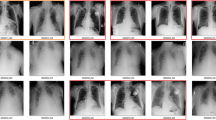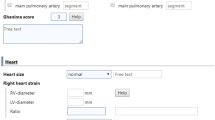Abstract
Structured radiology reporting has proved to be not only useful but also necessary in order to achieve completeness, comparability, and quantification and to minimize ambiguity. The introduction of electronic medical record (EMR) holds the promise of advancing clinical research by allowing analysis of data contained in the radiology reports; unfortunately, this is extremely difficult in free-form text, while it is quicker and easier in structured reports. Natural language processing (NLP) techniques automatically identify and extract features, which ML or DL algorithm process, for example, to classify radiology reports. Therefore, free text reports gathered retrospectively can be converted to semantic terminology by NLP. The use of structured reporting templates is also the way in which images to be used for the creation of AI models can be properly annotated with the radiological findings. A further step in the structured reporting is the inclusion of automatically generated quantitative imaging biomarkers in the report. The goal is not to create a fully quantitative report, which would resemble the way in which blood tests are reported, but to combine the findings detected by the radiologist with the associated annotations and quantitative metrics derived with a perfect combination between quantitative data and radiologist impressions.
Access this chapter
Tax calculation will be finalised at checkout
Purchases are for personal use only
Similar content being viewed by others
References
European Society of Radiology (ESR). ESR paper on structured reporting in radiology. Insights. Imaging. 2018;9(1):1–7. https://doi.org/10.1007/s13244-017-0588-8. Epub 2018 Feb 19.
Institute of Medicine (US) Committee on Data Standards for Patient Safety. Key Capabilities of an Electronic Health Record System: Letter Report. Washington, DC: National Academies Press (US); 2003. https://www.ncbi.nlm.nih.gov/books/NBK221802/.
Cai T, Giannopoulos AA, Yu S, Kelil T, Ripley B, Kumamaru KK, Rybicki FJ, Mitsouras D. Natural language processing technologies in radiology research and clinical applications. Radiographics. 2016;36(1):176–91. https://doi.org/10.1148/rg.2016150080.
Kok JN, Boers EJW, Kosters WA, van der Putten P, Poel M. Artificial intelligence: definition, trends, techniques and cases. Encyclopedia of Life Support Systems (EOLSS). UNESCO-EOLSS.
Pons E, Braun LM, Hunink MG, Kors JA. Natural language processing in radiology: a systematic review. Radiology. 2016;279(2):329–43. https://doi.org/10.1148/radiol.16142770.
Martí-Bonmatí L, Ruiz-Martínez E, Ten A, Alberich-Bayarri A. How to integrate quantitative information into imaging reports for oncologic patients. Radiologia. 2018;60(Suppl 1):43–52. https://doi.org/10.1016/j.rx.2018.02.005. Epub 2018 Mar 28.
Montoliu-Fornas G, Martí-Bonmatí L. Magnetic resonance imaging structured reporting in infertility. Fertil Steril. 2016;105(6):1421–31. https://doi.org/10.1016/j.fertnstert.2016.04.005. Epub 2016 Apr 19.
Medina García R, Torres Serrano E, Segrelles Quilis JD, Blanquer Espert I, Martí Bonmatí L, Almenar Cubells D. A systematic approach for using DICOM structured reports in clinical processes: focus on breast cancer. J Digit Imaging. 2015;28(2):132–45. https://doi.org/10.1007/s10278-014-9728-6.
Segrelles JD, Medina R, Blanquer I, Martí-Bonmatí L. Increasing the efficiency on producing radiology reports for breast cancer diagnosis by means of structured reports. A comparative study. Methods Inf Med. 2017;56(3):248–60. https://doi.org/10.3414/ME16-01-0091. Epub 2017 Feb 21.
Kao A, Poteet S. Overview. In: Kao A, Poteet S, editors. Natural language processing and text mining. New York, NY: Springer; 2007. p. 1–7.
National Library of Medicine (U.S.). UMLS reference Manual, Chapter 1, Introduction to the UMLS. 2009. http://www.ncbi.nlm.nih.gov/books/NBK9675/. Accessed 20 Mar 2021.
Chapman WW, Bridewell W, Hanbury P, Cooper GF, Buchanan BG. A simple algorithm for identifying negated findings and diseases in discharge summaries. J Biomed Inform. 2001;34(5):301–10.
Friedman C, Alderson PO, Austin JH, Cimino JJ, Johnson SB. A general natural-language text processor for clinical radiology. J Am Med Inform Assoc. 1994;1(2):161–74.
Friedman C, Shagina L, Lussier Y, Hripcsak G. Automated encoding of clinical documents based on natural language processing. J Am Med Inform Assoc. 2004;11(5):392–402.
Yu S, Kumamaru KK, George E, et al. Classification of CT pulmonary angiography reports by presence, chronicity, and location of pulmonary embolism with natural language processing. J Biomed Inform. 2014;52:386–93.
Goecks J, Jalili V, Heiser LM, Gray JW. How machine learning will transform biomedicine. Cell. 2020;181(1):92–101. https://doi.org/10.1016/j.cell.2020.03.022.
Uzuner O, Zhang X, Sibanda T. Machine learning and rule-based approaches to assertion classification. J Am Med Inform Assoc. 2009;16(1):109–15.
Elkin PL, Froehling D, Wahner-Roedler D, et al. NLP-based identification of pneumonia cases from free-text radiological reports. AMIA Annu Symp Proc. 2008;2008:172–6.
Cheng LT, Zheng J, Savova GK, Erickson BJ. Discerning tumor status from unstructured MRI reports—completeness of information in existing reports and utility of automated natural language processing. J Digit Imaging. 2010;23(2):119–32. https://doi.org/10.1007/s10278-009-9215-7. Epub 2009 May 30.
Soffer S, Ben-Cohen A, Shimon O, Amitai MM, Greenspan H, Klang E. Convolutional neural networks for radiologic images: a radiologist’s guide. Radiology. 2019;290:590–606.
Chartrand G, Cheng PM, Vorontsov E, et al. Deep learning: a primer for radiologists. Radiographics. 2017;37:2113–31.
Khaki S, Wang L, Archontoulis SV. A CNN-RNN framework for crop yield prediction. Front Plant Sci. 2020;10:1750. https://doi.org/10.3389/fpls.2019.01750.
Kim Y. Convolutional neural networks for sentence classification. arXiv preprint arXiv:14085882. 2014. https://arxiv.org/abs/1408.5882. Accessed Mar 2021.
Hochreiter S, Schmidhuber J. Long short-term memory. Neural Comput. 1997;9:1735–80.
Ruder S. NLP’s ImageNet moment has arrived. 2018. https://thegradient.pub/nlp-imagenet/. Accessed Mar 2021.
Knirsch CA, Jain NL, Pablos-Mendez A, Friedman C, Hripcsak G. Respiratory isolation of tuberculosis patients using clinical guidelines and an automated clinical decision support system. Infect Control Hosp Epidemiol. 1998;19(2):94–100.
Hripcsak G, Austin JH, Alderson PO, Friedman C. Use of natural language processing to translate clinical information from a database of 889,921 chest radiographic reports. Radiology. 2002;224(1):157–63.
Chapman BE, Lee S, Kang HP, Chapman WW. Document-level classification of CT pulmonary angiography reports based on an extension of the ConText algorithm. J Biomed Inform. 2011;44(5):728–37. https://doi.org/10.1016/j.jbi.2011.03.011. Epub 2011 Apr 1.
Chen MC, Ball RL, Yang L, et al. Deep learning to classify radiology free-text reports. Radiology. 2018;286:845–52.
Miao S, Xu T, Wu Y, Xie H, Wang J, Jing S, Zhang Y, Zhang X, Yang Y, Zhang X, Shan T, Wang L, Xu H, Wang S, Liu Y. Extraction of BI-RADS findings from breast ultrasound reports in Chinese using deep learning approaches. Int J Med Inform. 2018;119:17–21. https://doi.org/10.1016/j.ijmedinf.2018.08.009. Epub 2018 Aug 18.
Trivedi H, Mesterhazy J, Laguna B, Vu T, Sohn JH. Automatic determination of the need for intravenous contrast in musculoskeletal MRI examinations using IBM Watson’s natural language processing algorithm. J Digit Imaging. 2018;31:245–51.
Rink B, Roberts K, Harabagiu S, et al. Extracting actionable findings of appendicitis from radiology reports using natural language processing. AMIA Jt Summits Transl Sci Proc. 2013;2013:221.
Lacson R, Prevedello LM, Andriole KP, et al. Factors associated with radiologists’ adherence to Fleischner Society guidelines for management of pulmonary nodules. J Am Coll Radiol. 2012;9(7):468–73.
Rajpurkar P, Irvin J, Zhu K et al. CheXNet: radiologist-level pneumonia detection on chest X-rays with deep learning. 2017. http://arxiv.org/abs/1711.05225v3. Accessed 30 Mar 2021.
Oakden-Rayner L. CheXNet: an in-depth review. 2018. https://lukeoakdenrayner.wordpress.com/2018/01/24/chexnet-an-in-depth-review/. Accessed 30 Mar 2021.
Pinto dos Santos D. The value of structured reporting for AI: opportunities, applications and risks. 2019. https://doi.org/10.1007/978-3-319-94878-2_7.
Bizzo BC, Almeida RR, Alkasab TK. Computer-assisted reporting and decision support in standardized radiology reporting for cancer imaging. JCO Clin Cancer Inform. 2021;5:426–34. https://doi.org/10.1200/CCI.20.00129.
Goldberg-Stein S, Chernyak V. Adding value in radiology reporting. J Am Coll Radiol. 2019;16(9 Pt B):1292–8. https://doi.org/10.1016/j.jacr.2019.05.042.
Author information
Authors and Affiliations
Corresponding author
Editor information
Editors and Affiliations
Rights and permissions
Copyright information
© 2022 European Society of Medical Imaging Informatics (EuSoMII)
About this chapter
Cite this chapter
Fanni, S.C., Gabelloni, M., Alberich-Bayarri, A., Neri, E. (2022). Structured Reporting and Artificial Intelligence. In: Fatehi, M., Pinto dos Santos, D. (eds) Structured Reporting in Radiology. Imaging Informatics for Healthcare Professionals. Springer, Cham. https://doi.org/10.1007/978-3-030-91349-6_8
Download citation
DOI: https://doi.org/10.1007/978-3-030-91349-6_8
Published:
Publisher Name: Springer, Cham
Print ISBN: 978-3-030-91348-9
Online ISBN: 978-3-030-91349-6
eBook Packages: MedicineMedicine (R0)




